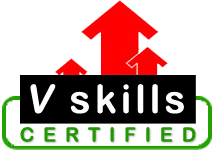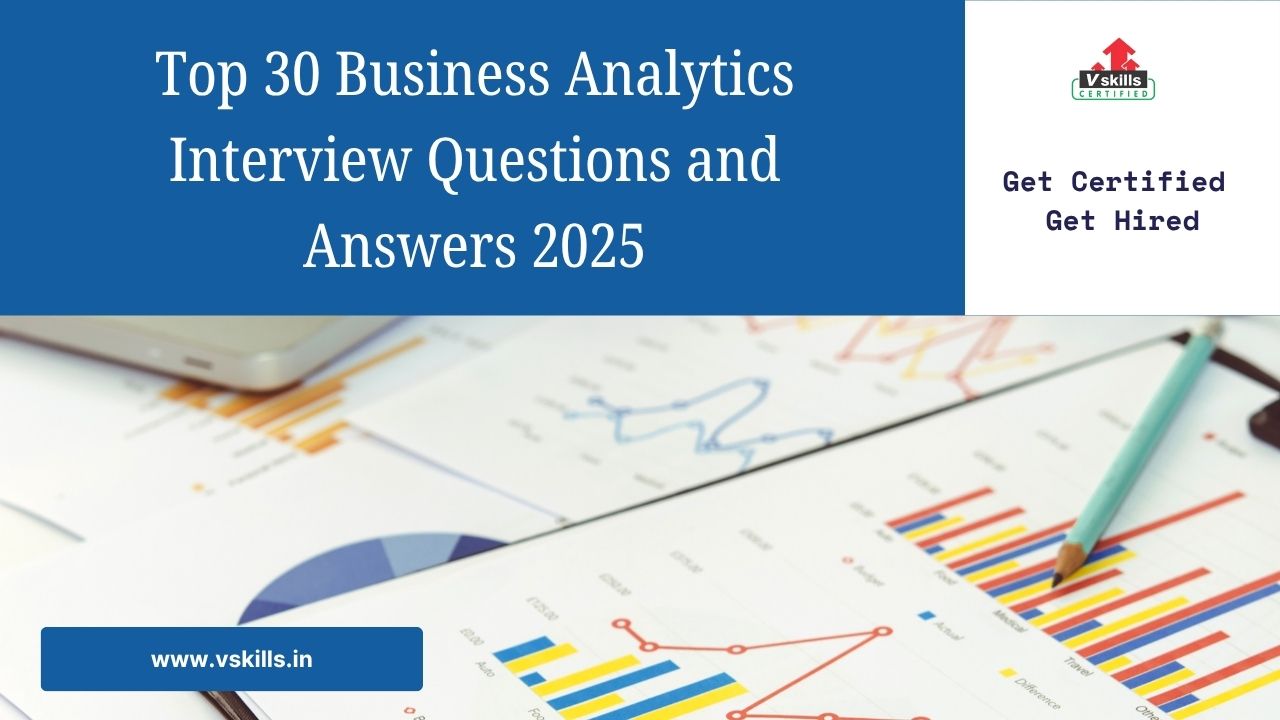In a world increasingly run by data, business analysts are no longer just support roles—they are strategic drivers of decision-making. As we step into 2025, companies aren’t just looking for people who can crunch numbers—they’re after professionals who can translate complex data into real business outcomes. Whether you are a fresh graduate aiming to break into the field or a seasoned analyst preparing for your next big move, one thing is clear: the right preparation can set you apart in a sea of resumes. That’s where this blog comes in. We have curated 30 of the most relevant, insightful, and frequently asked Business Analytics interview questions for 2025, complete with clear, concise, and updated answers that reflect what top recruiters are really looking for.
So if you are serious about landing your next analytics role, it’s time to level up your preparation with questions that go beyond theory and test your true business sense.
In today’s data-driven world, Business Analytics (BA) has become the gold that unlocks crucial insights, drives strategic decisions, and shapes every industry imaginable. The demand for skilled BA professionals is booming, but so is the competition. Cracking that interview and landing your dream BA job requires not just technical prowess, but also a sharp mind for storytelling and the ability to translate data into actionable wisdom.
This blog is your ultimate weapon for interview prep. We’ve compiled the top 30 Business Analytics interview questions and answers for 2025, meticulously crafted to cover the spectrum of essential skills and knowledge recruiters crave. From foundational concepts to real-world problem-solving, we’ll equip you with the confidence and insights to navigate your interview with grace and poise.
So, buckle up, data enthusiasts! Get ready to dive deep into the world of numbers, algorithms, and the art of transforming raw data into business gold. Let’s conquer those interview anxieties and turn them into opportunities to showcase your brilliance. The future of data-driven decision-making awaits!
Decoding the Data Game
In today’s data-obsessed world, numbers aren’t just numbers, they’re the secret language of success. And who deciphers this language? The Business Analyst (BA) – the modern-day interpreter of insights, the translator of trends, and the architect of data-driven decisions. No wonder BA professionals are in high demand across every industry, from tech giants to startups, finance to healthcare.
This blog targets both aspiring data detectives seeking to crack the BA code and seasoned analysts wanting to hone their skills and climb the career ladder. Whether you’re a job seeker yearning to land your dream role or a working professional aiming to level up, mastering the top 30 BA interview questions and answers presented here will be your ultimate weapon.
But why is this knowledge so crucial? Because as a BA, you’re not just a number cruncher – you’re a storyteller, a strategist, and a problem solver. You take raw data, analyze it with precision, and weave it into compelling narratives that illuminate trends, predict outcomes, and guide businesses towards smarter decisions. This, in turn, unlocks a treasure trove of advantages:
- For job seekers: Equip yourself with the confidence and expertise to impress interviewers, secure your dream BA job, and become a sought-after data alchemist.
- For working professionals: Sharpen your analytical skills, impress clients and colleagues with your insights, and fast-track your career advancement to leadership roles within the data-driven landscape.
Let’s now look at the typical BA Interview process.
Understanding the Typical Business Analyst Interview Process
Landing your dream Business Analyst (BA) job takes more than just technical prowess and data smarts; it’s about excelling in the interview process. While the specifics can vary slightly depending on the company and industry, understanding the typical stages can help you navigate the journey with confidence:
1. Phone Screening: This initial contact is your chance to make a strong first impression. Be prepared to discuss your resume, highlight relevant skills and experience, and showcase your enthusiasm for the BA role.
2. Technical Assessment: You may be asked to complete online tests to assess your analytical and technical skills. Be familiar with common BA tools and methodologies, and practice data interpretation and problem-solving exercises.
3. Panel Interview: This is where you meet a team of hiring managers or specialists. Expect questions about your understanding of BA concepts, problem-solving approach, and experience applying specific tools and techniques. Be prepared to showcase your communication skills and ability to collaborate effectively.
4. Case Study or Simulation: You might be presented with a real-world business problem and asked to analyze it, propose solutions, and demonstrate your decision-making abilities. Think critically, showcase your analytical framework, and don’t shy away from asking clarifying questions.
5. Final Interview: This could be with a senior leader or the decision-maker. Be prepared for questions about your career goals, fit within the company culture, and long-term vision as a BA. Emphasize your passion for data, willingness to learn, and potential contributions to the team.
Bonus Tips:
- Research the company and the specific BA role thoroughly.
- Prepare insightful questions to demonstrate your genuine interest.
- Practice your answers to common interview questions.
- Dress professionally and maintain a positive attitude.
- Follow up with a thank-you note after each interview stage.
Remember, the interview process is a two-way street. While you’re being evaluated, you’re also assessing the company culture and fit for your career aspirations. Stay confident, showcase your unique skills, and let your passion for data shine through!
What makes you the best fit for a Business Analytics role?
Two crucial aspects of landing your dream Business Analyst (BA) role are mastering the STAR method for interview answers and convincingly conveying your unique fit for the company. Let’s dive into each:
1. The STAR Method: Your Interview Answer Weapon
The STAR method is a powerful framework for structuring your interview responses, particularly when addressing behavioral questions. It stands for:
- Situation: Briefly describe the context of the scenario. What was the problem, challenge, or opportunity you faced?
- Task: Define your specific role or responsibility in that situation. What were you tasked with achieving?
- Action: Explain the actions you took to address the situation. What specific skills, knowledge, or strategies did you employ?
- Result: Highlight the outcome of your actions. What impact did you have? Did you achieve the desired result? Quantify your achievements if possible.
Using the STAR method ensures your answers are clear, concise, and focused on action and results. It showcases your problem-solving skills, initiative, and ability to handle challenging situations – all essential qualities for a successful BA.
2. Demonstrating Your Unique Fit for the BA Role:
Proving you’re the perfect candidate for a specific company’s BA role goes beyond technical skills. Here are some key strategies:
- Research the company thoroughly: Understand their industry, business goals, and existing data infrastructure.
- Tailor your answers to their specific needs: Align your skills and experience with the challenges and opportunities mentioned in the job description.
- Showcase your passion for data analysis: Express your enthusiasm for problem-solving and uncovering insights from data.
- Highlight your communication and collaboration skills: Emphasize your ability to translate complex data into actionable insights for non-technical stakeholders.
- Share examples of successes in similar roles: Provide concrete examples of how you’ve applied your BA skills to solve real-world problems and achieve measurable results.
- Show your cultural fit: Demonstrate how your personality, values, and work ethic align with the company culture.
Remember, it’s not just about checking boxes, but about creating a compelling narrative that demonstrates your unique value proposition as a BA.
Top 30 Business Analytics Professional interview questions
By combining the power of the STAR method with a strategic approach tailored to the specific company, you can confidently walk into any interview knowing you’ll present yourself as the most qualified and enthusiastic candidate for the BA role. These are the Top business analytics professional interview questions along with Top business analytics professional interview questions for freshers –
1. What are the core skills and qualities of a successful Business Analyst?
Answer: Strong analytical and problem-solving abilities, excellent communication and presentation skills, proficiency in data analysis tools like SQL and Excel, attention to detail, ability to collaborate effectively with stakeholders, and a proactive and curious mindset.
2. Explain the difference between descriptive, predictive, and prescriptive analytics in the context of business insights.
Answer: Descriptive analytics describe what happened in the past (e.g., sales trends). Predictive analytics use historical data to forecast future outcomes (e.g., customer churn). Prescriptive analytics go beyond prediction, recommending specific actions to optimize outcomes (e.g., targeted marketing campaigns).
3. Describe your experience with data cleaning and transformation processes.
Answer: (Use the STAR method here.) Briefly describe a project where you encountered messy data. Explain the specific techniques you used to clean and transform it (e.g., handling missing values, identifying outliers, data normalization). Highlight the positive impact your efforts had on the project’s results.
4. How do you approach a business problem requiring analysis?
Answer: I follow a structured approach. First, I define the problem and gather relevant data. Then, I analyze the data using appropriate tools and techniques. Next, I communicate my findings and insights to stakeholders. Finally, I monitor the outcomes and iterate on my analysis as needed.
5. Explain your experience with building and presenting data visualizations.
Answer: (Highlight specific tools and skills) I’m proficient in creating visuals like charts, graphs, and dashboards using tools like Tableau or Power BI. I ensure my visualizations are clear, concise, and tailored to the audience’s understanding. I can explain the insights derived from the visuals in a compelling and actionable way.
6. How do you handle situations where stakeholders disagree with your data-driven recommendations?
Answer: I maintain a collaborative approach. I present my findings objectively with supporting evidence. I actively listen to their concerns and try to understand their perspective. If necessary, I revise my recommendations or provide additional data to address their concerns.
7. Describe your experience with Agile methodologies and how they apply to BA work.
Answer: I understand the iterative and collaborative nature of Agile. I am familiar with working in sprints, prioritizing tasks based on user needs, and adapting to changing requirements. I can effectively communicate data insights to Agile teams to inform their decision-making.
8. How do you stay up-to-date with the latest trends and advancements in the Business Analytics field?
Answer: I attend industry conferences and webinars, follow relevant blogs and online communities, and read industry publications. I am always keen to learn new tools and techniques to stay ahead of the curve.
9. What are your salary expectations for this role?
Answer: Research the average salary for BA roles in your location and experience level. Provide a range that is fair and competitive, while remaining open to negotiation based on the specific offer and benefits package.
10. Are you familiar with any specific data analysis tools or methodologies relevant to this role?
Answer: Research the company’s preferred tools and technologies. Highlight your proficiency in relevant tools like SQL, Python, R, Tableau, or Power BI. Demonstrate your willingness to learn new tools and adapt to the company’s specific data ecosystem.
11. Share an example of a time you identified a hidden trend or insight within data that others missed.
Answer: (Use the STAR method) Briefly describe a project where you noticed a seemingly insignificant pattern in the data. Explain how you explored this further and discovered a valuable insight that impacted business decisions (e.g., identifying a previously unknown customer segment with high purchase potential).
12. How do you measure the success of a data analysis project?
Answer: I consider multiple factors like the quality of insights generated, the impact on business decisions, the reduction in costs or improvement in efficiency, and the increased ROI. Quantitative metrics are important, but I also recognize the value of qualitative feedback from stakeholders.
13. Describe your experience with data security and privacy regulations relevant to your industry.
Answer: I understand the importance of protecting sensitive data. I am familiar with data security best practices and relevant regulations like GDPR or HIPAA. I ensure my analysis adheres to these regulations and maintain ethical data handling practices.
14. Explain your approach to communicating complex data insights to non-technical stakeholders.
Answer: I avoid technical jargon and focus on storytelling. I tailor my communication to the audience’s level of understanding, using clear language and relevant examples. I visualize data effectively and present actionable recommendations in a simple and compelling way.
15. What are your career goals as a Business Analyst?
Answer: Express your ambitions and how this role fits into your long-term career trajectory. Mention your desire to develop specialized skills, take on leadership roles, or contribute to specific industry domains. Show your enthusiasm for continuous learning and growth within the BA field.
16. How do you manage your time effectively when working on multiple projects with competing deadlines?
Answer: I prioritize tasks based on urgency and importance. I leverage project management tools and effectively communicate with stakeholders to manage expectations. I delegate tasks when appropriate and remain adaptable to changing priorities.
17. Describe your experience with data governance and quality management processes.
Answer: I understand the importance of maintaining data integrity and quality. I am familiar with data governance practices and quality control procedures. I can ensure data traceability, accuracy, and consistency throughout the analysis process.
18. How do you handle uncertainty and ambiguity in data-driven projects?
Answer: I maintain a flexible and analytical approach. I acknowledge the limitations of data and potential biases. I consider various scenarios and present my findings with clear caveats. I actively seek feedback from stakeholders to refine my analysis and address uncertainties.
19. Share an example of a time you faced a significant challenge in a data analysis project and how you overcame it.
Answer: (Use the STAR method) Briefly describe a challenging situation where you encountered technical difficulties, data limitations, or unexpected results. Explain how you approached the challenge, the techniques you used to overcome it, and the lessons you learned from the experience.
20. Do you have any questions for us?
Answer: This is your chance to learn more about the company, the team, and the specific role. Ask insightful questions that show your genuine interest and understanding of the BA function within the company.
Business Analyst scenario-based interview questions and answers
1. Imagine you’re tasked with analyzing customer churn for an e-commerce platform. What steps would you take to identify the root causes and potential solutions?
Answer: (Use the STAR method) Explain how you’d gather data on customer demographics, purchase history, engagement metrics, and customer support interactions. You’d analyze this data using correlation analysis and segmentation techniques to identify patterns and groups with high churn rates. Based on the findings, you’d propose solutions like targeted marketing campaigns, personalized product recommendations, improved customer service training, or UI/UX enhancements.
2. You’re presented with a real-time dashboard showing a sudden drop in website traffic for a financial services company. How would you diagnose the issue and recommend action?
Answer: You’d analyze the dashboard for anomalies and compare it to historical data. You’d investigate potential causes like marketing campaign changes, website outages, competitor activity, or search engine ranking fluctuations. Based on your findings, you’d recommend immediate actions like investigating technical issues, adjusting marketing campaigns, or analyzing competitor strategies.
3. A software development team wants to implement a new feature, but the data suggests it might not be profitable. How would you communicate this to them while offering alternative solutions?
Answer: You’d present your findings and data-driven insights objectively, ensuring clear communication and respectful collaboration. You’d analyze alternative options with them, exploring potential cost reductions, A/B testing ideas, or phased implementation strategies.
4. You’re managing a data analysis project with tight deadlines and conflicting priorities from different stakeholders. How would you navigate this situation?
Answer: You’d facilitate open communication, gather stakeholder input, and prioritize tasks based on impact and feasibility. You’d explain the potential consequences of delayed tasks and propose efficient solutions like phased deliveries or agile adjustments.
5. Imagine you’re working with incomplete or inaccurate data for a project. How would you handle this challenge and ensure reliable results?
Answer: You’d assess the data quality issues, document the limitations, and communicate transparency to stakeholders. You’d utilize data cleaning techniques, seek additional data sources, or consider alternative analysis methods while acknowledging potential uncertainties in your findings.
6. You’re analyzing sales data for a retail store and notice a suspicious spike in one region. How would you investigate this anomaly and determine its cause?
Answer: You’d further analyze the regional data, comparing it to national trends and looking for specific product categories or specific timeframes within the spike. You’d research potential external factors like local events, competitor promotions, or regional marketing campaigns to determine the cause.
7. A healthcare startup wants to predict patient readmission rates. How would you approach this data analysis challenge?
Answer: You’d gather patient data on demographics, medical history, treatment plans, and readmission records. You’d utilize predictive modeling techniques like logistic regression or machine learning algorithms to identify risk factors and potential readmission triggers.
8. You’re tasked with evaluating the effectiveness of a social media marketing campaign. What metrics would you track and how would you interpret the results?
Answer: You’d track engagement metrics like reach, impressions, clicks, shares, and follower growth. You’d analyze website traffic, conversions, and brand sentiment to assess the campaign’s impact on overall brand awareness and sales.
9. You’re working on a data analysis project for a manufacturing company, and their IT department suggests a new data visualization tool. How would you evaluate its suitability for your needs?
Answer: You’d research the tool’s features and capabilities, comparing them to your current tools and project requirements. You’d consider factors like data handling capabilities, ease of use, integration with existing systems, and user feedback from other teams.
10. A project you’re working on unexpectedly generates negative publicity for the company. How would you handle this situation and prevent similar issues in the future?
Answer: You’d proactively communicate the situation to stakeholders, analyzing the data and identifying the root cause of the negative publicity. To prevent similar occurrences, you’d propose solutions like data governance revisions, improved communication protocols, or additional data quality checks.
Why become a Vskills Certified Business Analytics Professional?
The Vskills Certified Business Analytics Professional certification is a government-recognized credential (under the Ministry of Skill Development & Entrepreneurship) aimed at equipping professionals with core data analysis skills and business insight to make informed decisions based on data. Whether you’re entering the world of analytics or upgrading your skills, this certification gives you a solid, job-oriented foundation.
Why Choose Vskills Business Analytics Certification?
- Industry-Relevant Curriculum: Covers the complete analytics lifecycle—from data collection to actionable insight generation.
- Government Certification: Get certified by India’s largest certification body for skills testing. Recognized by employers and valued across industries.
- Lifetime Validity: Your certification doesn’t expire—no need for renewals or retakes.
- Online Exam + Learning Access: Flexible online learning and testing. Study at your pace, from anywhere.
- Free Practice Tests + Hard Copy Materials: Get access to sample questions and printed study materials shipped to your address.
What You Will Learn?
The course focuses on building both analytical and business thinking. Topics include:
- Introduction to Business Analytics
- Data Types & Data Management
- Data Summarization Techniques
- Statistical Analysis & Hypothesis Testing
- Data Mining Concepts
- Regression and Forecasting Techniques
- Data Visualization Tools (Excel, Power BI, Tableau – overview)
- Business Applications of Analytics
Who should take this Certification?
- Aspiring Business Analysts
- Working professionals in Finance, Marketing, or HR
- MBA students or graduates
- IT professionals looking to shift to data-driven roles
- Entrepreneurs wanting to leverage data for business growth
Career Opportunities
Upon certification, you can pursue roles like:
- Business Analyst
- Data Analyst
- Research Analyst
- Operations Analyst
- MIS Executive
- Market Analyst
Key Benefits
- Boosts your resume with a government-certified credential.
- Adds value to your LinkedIn profile and job applications.
- Shows employers that you’re data-literate and decision-ready.
- Increases your chances of getting shortlisted for analytics-related roles.
Exam Details
- Mode: Online
- Format: Multiple Choice Questions (MCQs)
- Duration: 60 minutes
- Passing Marks: 50%
- Negative Marking: No
The Vskills Certified Business Analytics Professional certification is a smart, low-investment, high-return option for anyone serious about stepping into analytics. With practical coverage and a respected credential, it’s the ideal launchpad for data-driven careers in 2025 and beyond.
Business Analytics Table of Contents
https://www.vskills.in/certification/business-analytics-professional-table-of-contents
Business Analytics Practice Test
https://www.vskills.in/practice/business-analytics
Business Analytics Tutorials
Companies that hire Business Analytics
Vskills Certified Business Analytics Candidate will find employment in Top MNC’s and organisations like Groupon, Amazon India, TCS, Accenture, Exide Life Insurance, Mastercard, JP Morgan Chase.
Final Words
As we wrap up, remember that cracking those BA interviews is about much more than just technical wizardry. It’s about showcasing your passion for data, your ability to translate the language of numbers into actionable insights, and your confident collaboration with stakeholders. Embrace the challenge, sharpen your story, and let your unique expertise shine. The future of data-driven decisions awaits, and you, the aspiring BA hero, hold the key to unlocking its potential. So, go forth, analyze, interpret, and conquer!
In the dynamic world of business analytics, it’s not just your technical skills that get you hired—it’s your ability to ask the right questions, draw meaningful insights, and drive decisions that make a measurable impact. Interviews are your opportunity to showcase this mindset. Remember, Preparation is no longer optional. It’s your competitive edge. We hope this guide gives you more than just answers—it gives you the confidence to walk into any interview and prove you’re not just a data expert, but a decision enabler.




